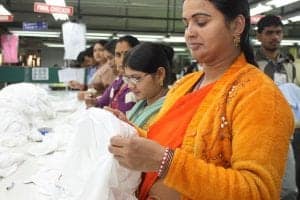Part one of a series on the opportunity to drive financial inclusion for low-income factory workers. Read part two here.
Figuring out how to turn millions of low-income women in India into active users of financial services is an enormous undertaking. One place that offers tremendous opportunity are factories.
Women’s financial inclusion in India

Although India’s “no-frills” PMJDY bank accounts and its government-backed insurance and pension schemes are promising developments—and are reaching a far larger segment of the low-income population than ever before—they do not go far enough to solve the financial inclusion challenge, especially for women. As of 2016, only 38% of women had PMJDY accounts and usage remains incredibly low.
So where does one start in the effort to turn low-income Indian women into more engaged users of formal financial services? Women’s World Banking’s research, supported by West Elm, shows that one promising place to start is inside India’s factories such as in bedding and garments.
 Factory workers: a captive market
Factory workers: a captive market
The demographics alone make a strong case: The country’s garment industry employs approximately 6 million people, 80 percent of whom are women and the majority of whom are in the two lowest income segments. But what makes these factories especially promising as a launching ground for increased financial inclusion is that it can build on existing benefit programs that workers use and value.
Women’s World Banking, in partnership with West Elm, looked at Fair Trade Certified factories*, which already offer salary payments through bank accounts and a variety of benefits such as purified water, free meals and snacks, educational access for children, and informative health-care fairs. Building on these services – including expanded financial products and education – would have immeasurable long-term rewards.
Indian low-income factory workers’ financial behavior
Most workers rely mainly on their salary accounts for daily needs and short-term savings. The majority of workers in the study, both men and women, used informal saving strategies such as chit funds or employees in assets for any goals beyond their daily or monthly expenses. For emergency needs, workers usually opt to borrow money from friends and family rather than from financial institutions, which require documentation and collateral that can seem too formal or daunting.
Financial and non-financial services as workers benefits

The findings in the study are also poised to have much broader implications. Millions of workers in the world’s most unbanked countries work in factories, and if programs in India’s factories have positive results, those programs can be scaled to other workplaces and regions. The result: Life-changing improvements in the financial inclusion of low-income men and women, not just in India but worldwide.
*company names undisclosed for confidentiality



